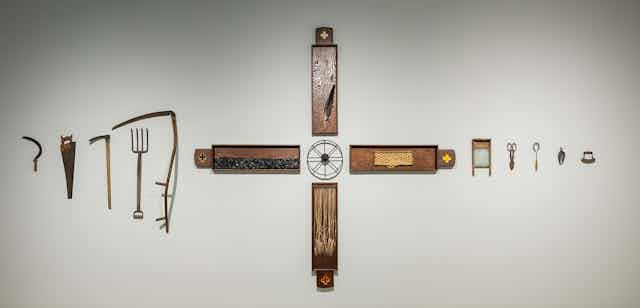How do we learn and teach about First Nations labour in ways that connect to local economies and Canadian history education?
In a new exhibition, Nii Ndahlohke / I Work, at Art Windsor Essex, labour is the central theme for understanding the history and legacies of Mount Elgin Industrial School, an Indian Residential School in southwestern Ontario.
The exhibition brings together artists from the communities whose children attended this institution, and it runs until June 24, 2024. It emerged from the Munsee Delaware Language and History Group, a community-based language and history learning project.
The group has worked together for many years to study and teach Munsee language and history, and supports research and teaching about Munsee people, communities, languages and territories.
Manual labour demands
Mount Elgin was located at Chippewas of the Thames First Nation in southwestern Ontario. Like other Industrial Schools of its era, Mount Elgin was an underfunded religious federal boarding school and a model farm that was expected to generate income to pay for itself.
Students at the school were expected to work at the institute as much as they were expected to attend class.
Their labour was invisible within the school budget. However, the Indian department was aware that Mount Elgin students were not given progressive training in skilled trades and that manual labour demands on students kept them out of the classroom and therefore compromised their education.

Farm labour, domestic service
Manual labour prepared students for limited work opportunities: farm labour for boys and men, and domestic service for girls and women.
These jobs supported the surrounding rural and urban settler economies at a time when First Nations were pressured to lease and even surrender reserve land to area farmers to round out meagre incomes.
Significantly, forced labour was a key issue in student resistance at Mount Elgin including running away, setting fires and attempting to ruin farm equipment. It was also a key issue in parents’ letters of complaints to the department and band attempts to intervene in federal schooling.
Hard labour also impacted the children’s health, and poor diet and stress compounded to accelerate the spread and deadliness of diseases like tuberculosis.
Labour as central theme

Nii Ndahloke / I Work, addresses histories of student labour at Mount Elgin but also its larger impact on reserve and settler economies of southwestern Ontario in the era.
The show also addresses histories of gendered experiences of Indian education, racism, student illness, intergenerational collaboration and the preservation of different forms of labour and the stories and metaphors that accompany them.
The majority of artists are from First Nations communities in southern Ontario. Artists featured in the exhibit are: Kaia’tanoron Dumoulin Bush, Jessica Rachel Cook, Nancy Deleary, Gig Fisher, Vanessa Dion Fletcher, Judy McCallum, Donna Noah, Mo Thunder and Meg Tucker.
Each of the artists were given three sources in common to inspire their work: a silent film about Mount Elgin entitled The Church in Action in an Indian Residential School (1943) produced by the United Church of Canada to promote its Home Missions work; a basic timeline of the school; and a physical and audio copy of the 2022 book Nii Ndahlohke: Boys’ and Girls’ Work at Mount Elgin Industrial School, 1890-1915. This book is the result of a project developed by the Munsee Delaware Language and History Group.

Artists’ own histories
The artists’ resulting works range widely and meaningfully address the artist’s own histories.
The exhibit presents the film in a separate room, with hand-sketched images of student uniforms and replica student graffiti from the walls of the last remaining Mount Elgin building, the barn.
As part of the exhibition design, a red line along the wall follows visitors around the exhibit. This line represents a story told to Julie, one of the authors of this story, by our relative Norma Richter, about sewing the red piping featured on the yoke of girls’ uniforms at the school she attended in the 1930s and 40s – one of the only half-interesting things she remembered doing in her years at the school.

It also commemorates Norma’s refusal of work, and the two times she ran away from the school. The representation of the red line grounds the exhibit in family and community history.

Community-based approach
The exhibition reflects a different approach to both history and curation.
As well as being a source for this exhibit, Nii Ndahlohke / I Work was created for an audience of local students and for use in the Ontario history curriculum, which, in Grade 8, covers the period 1890 to 1914.
The book is split into two sections, one on boys’ work and one on girls’ work. It also features Munsee language and Munsee artwork highlighting certain sections or themes.
The exhibit amplifies and starkly interprets the history of student labour at Mount Elgin.
We hope people will leave with is a better understanding of the residential school system in Canada as a shared history.

